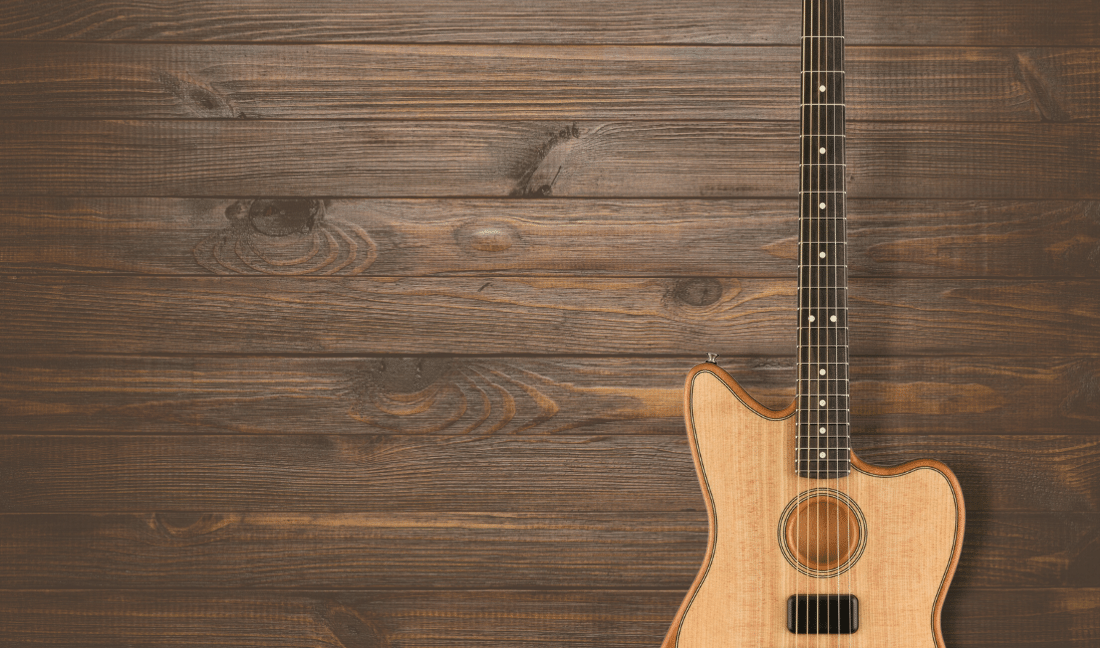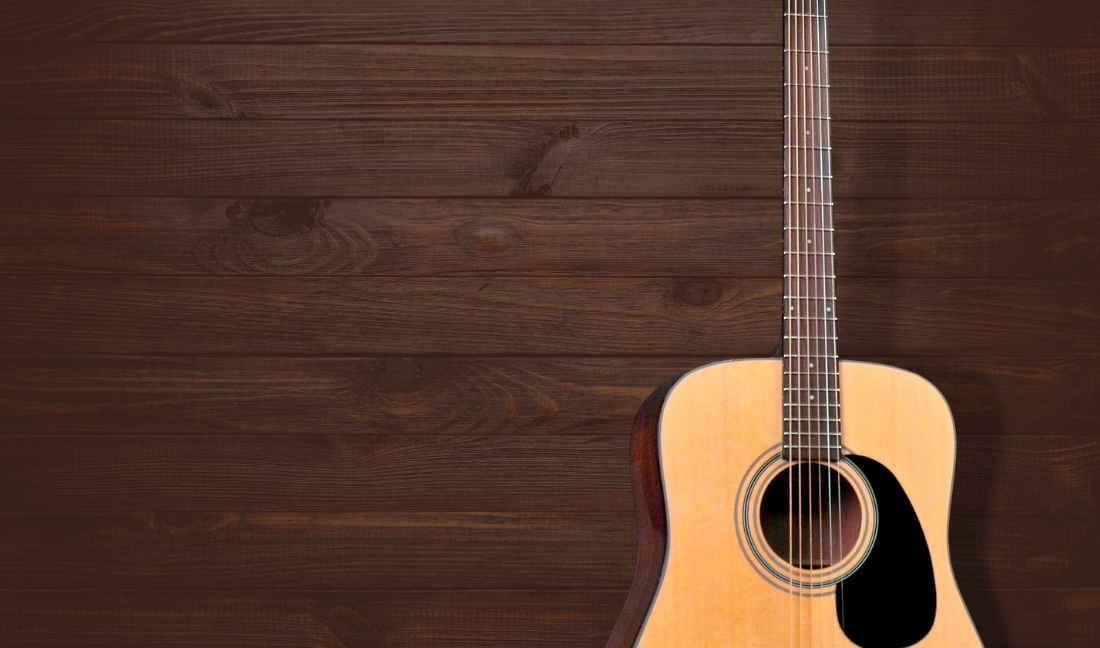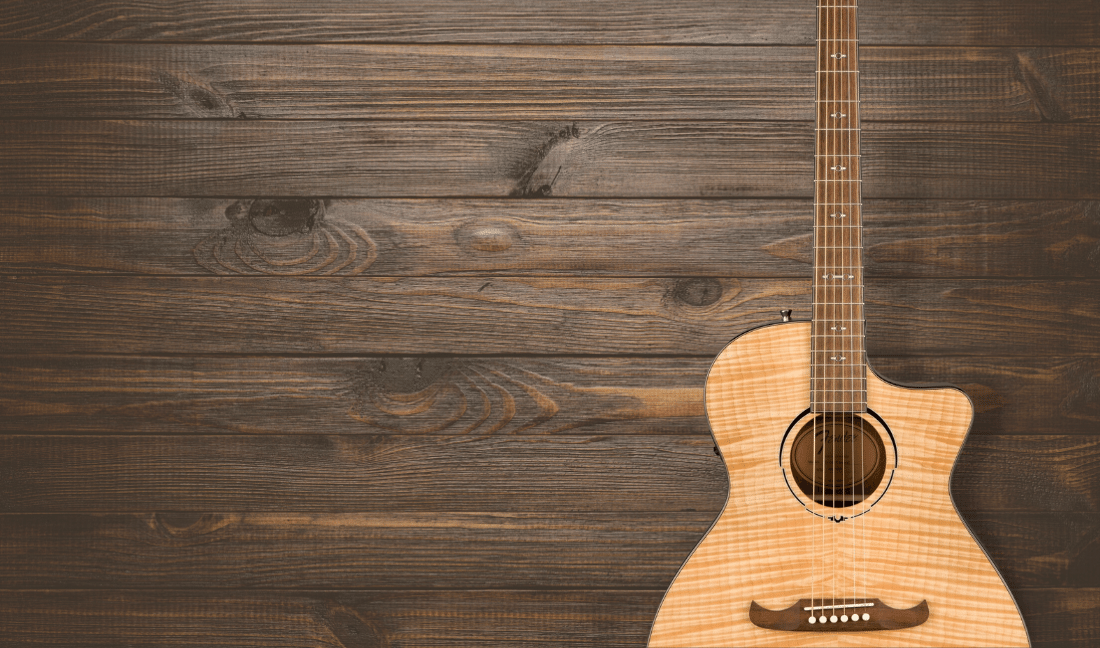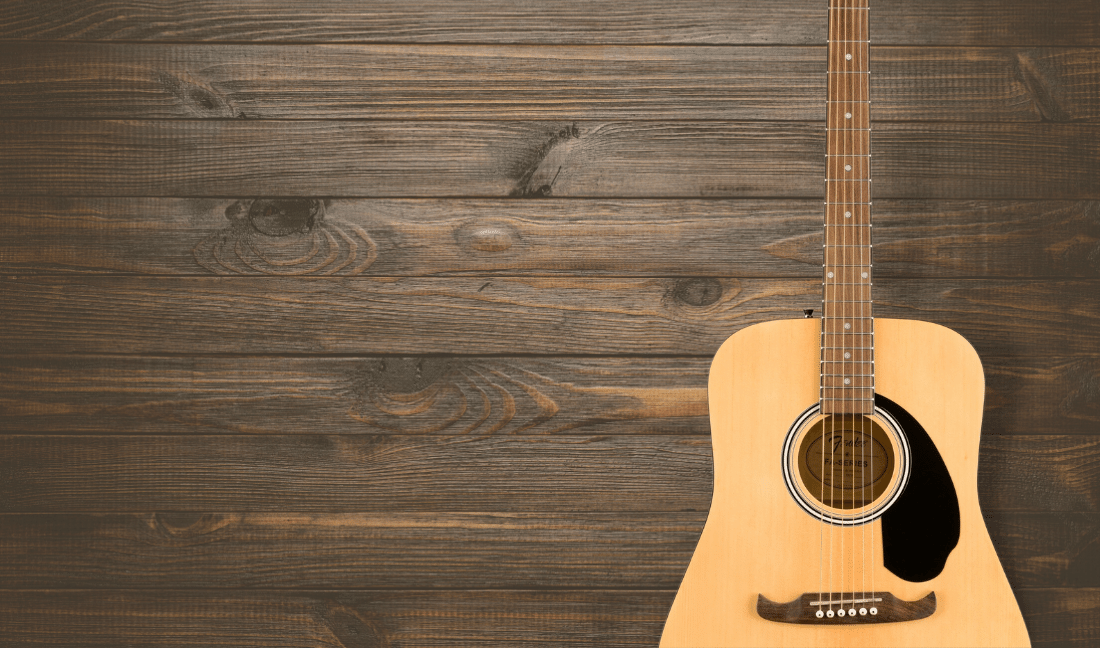For those of you looking for an acoustic guitar that both versatile and high quality, this Fender Acoustasonic Jazzmaster is a great option to consider.
It has a cutaway body with polyester satin matte finish, a top made of Sitka Spruce, a modern “Deep C” neck shape, and a 25.5″ scale length.
You can purchase this guitar in many different stores, some of them include:
We may earn commissions from these links at no additional cost to you.
In this review post, we’ll take a deep look at this acoustic guitar and examine its features, sound, and playability.
Certain guitar features can change the entire feel and worth of the instrument so it’s very important to choose wisely.
Table of Contents
Summary
Here’s a brief overview of how the Fender Acoustasonic Jazzmaster performs across different key points.
Just a heads up, these scores, and rating is our own personal opinion, so it might not match that of others out there.
Hardware
All the many metal and plastic elements that make up a guitar are referred to as the hardware.
These include but are not limited to:
- Tuning machines
- Pickguard
- Bridge
- Strings
- Strap buttons
- Pickups
- Tailpiece
- Control knobs
Fender’s acoustic guitars are known for having a very solid and durable construction.
The company has generally always used high-quality materials for its products, which is evident in many of the different successful models that they’ve built throughout the years.
When considering a guitar primarily on its hardware, check that it is of excellent quality and that it all looks strong enough to withstand consistent use.
For example, plastic saddles on the bridge, are common on lower-quality guitars, which can degrade the instrument’s tone and intonation while also making it more difficult to keep in tune.
You also don’t want any metal piece to rust or tarnish, and they should be sturdy and durable in order to avoid being damaged.
A well-sounding and playable guitar needs good hardware, and there are a few things that a manufacturer can do to make it ideal for us.
Let’s take a closer look!
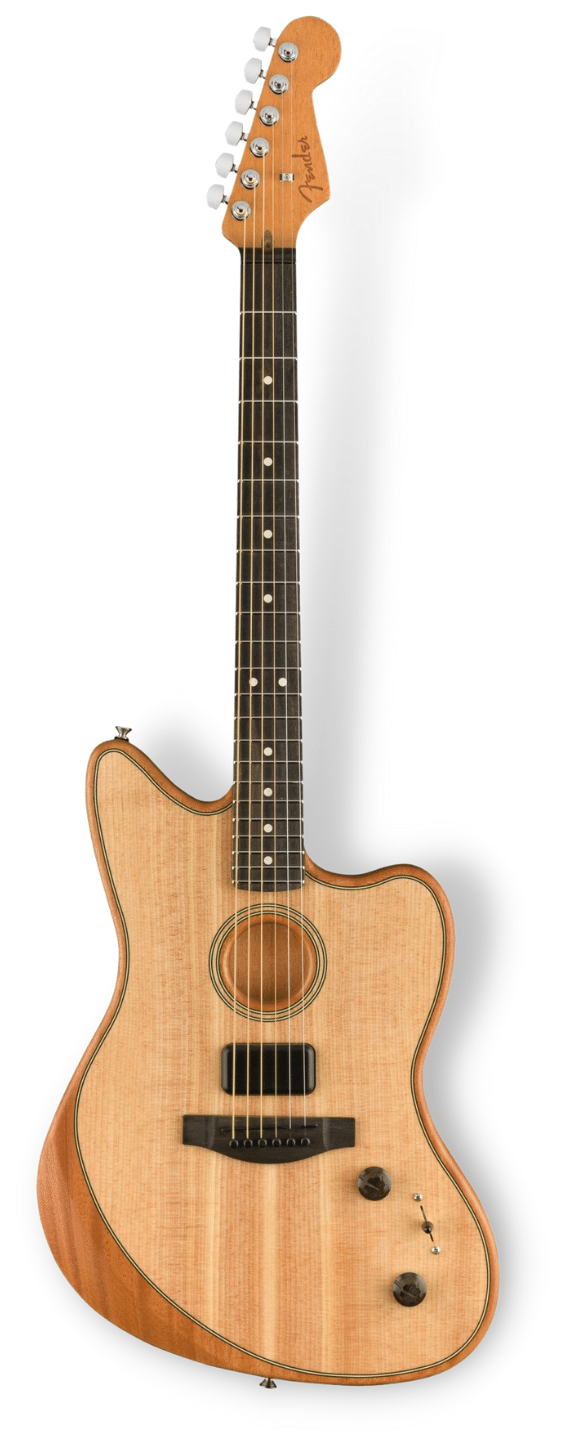
– Tuning Machines
On this Fender Acoustasonic Jazzmaster, the tuning machines are standard cast/sealed staggered, made of chrome, and have a closed gear design.
- Material: Chrome
- Design: Fender Standard Cast/Sealed Staggered
The tuning machines (or “tuners”) are one of the most important parts of the hardware on any guitar.
They’re responsible for holding the strings tight so that they can vibrate properly and produce the correct pitch.
Bad and low-quality tuning machines can make your guitar go out of tune quickly and be difficult to keep in tune.
They can also make it difficult to change the strings, and make the guitar in many ways, more difficult to play.
Must Remember:
Good tuning machines are made of strong and durable materials and have a precise and smooth action.
You’d want to look for materials such as chrome, nickel-plated steel, or stainless steel, which are less likely to rust.
These materials are also less likely to tarnish, so your guitar will look good for longer.
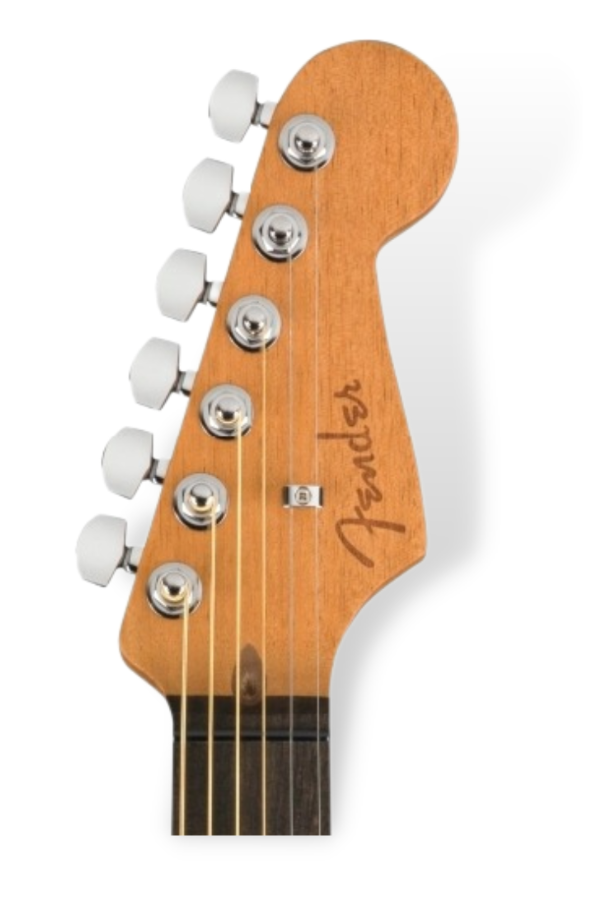
– Pickguard
The Fender Acoustasonic Jazzmaster doesn’t have a pickguard, which means that if you’re not careful enough when you play, you could damage its finish very easily.
- Color: Not applicable
- Design: Not applicable
It’s actually very interesting to see that Fender decided to not put a pickguard on this model.
Maybe it was simply a design decision, or there might be other reasons why, but this is one of the only “bad” things we saw about this guitar.
The pickguard is a small piece of plastic or metal that’s mounted on the body of the guitar, near the strings.
Its aim is to protect the guitar’s finish against scratches caused by the pick as you play.
Most pickguards are constructed of plastic or metal, in some cases, even carbon fiber, and there are a variety of styles to choose from.
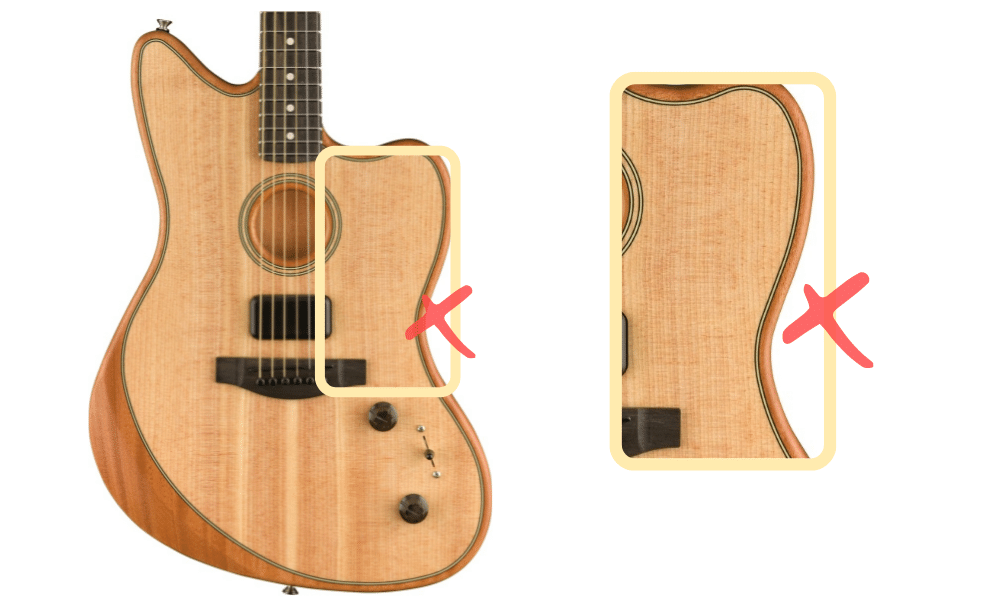
When it comes to pickguards, durability is an important factor to consider; they should be made of any material that can withstand regular use.
It also needs to be in a position where it’s likely to actually protect the body of the guitar from scratches caused by the player’s pick.
As for looks and style, a pickguard should also complement the overall aesthetic of the guitar.
It shouldn’t be too noticeable, but it shouldn’t be so little or low-quality that it seems out of place either.
– Strap Buttons
Both strap buttons on the Fender Acoustasonic Jazzmaster are constructed of chrome and are placed at the bottom and the top edge of the body.
- Material: Chrome
- Position: Bottom and top edge
- Design: Classic
Strap buttons are those small metal buttons that are mounted on the body of the guitar, and used to attach a strap to the instrument.
On the body of most guitars, there will be at least two strap buttons, one at the bottom, and another one anywhere by the neck of the instrument.
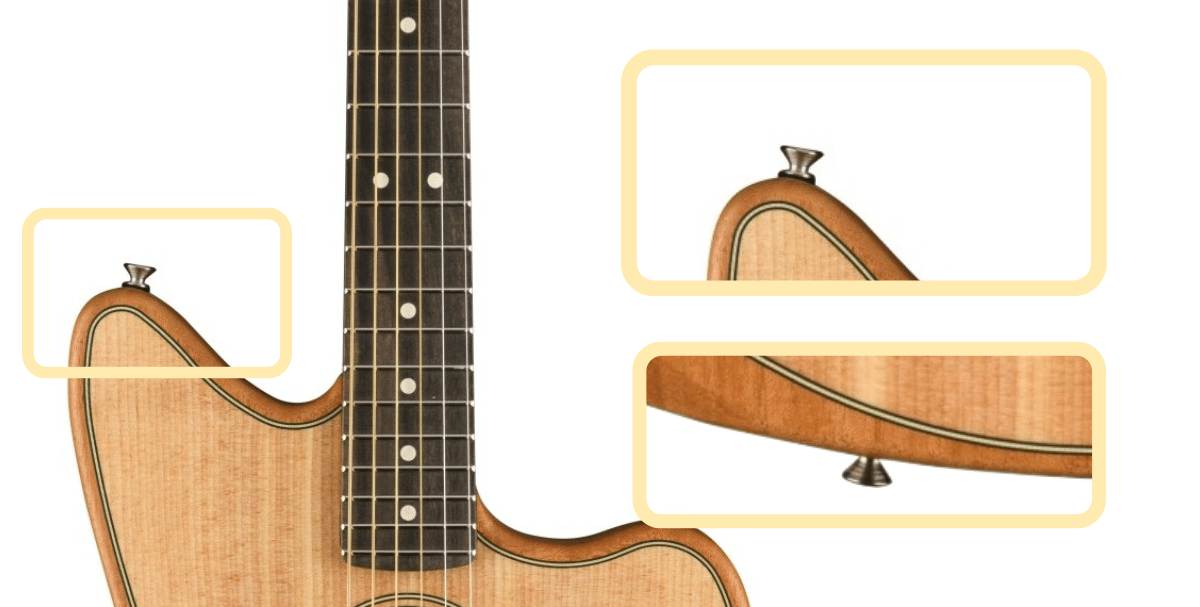
These strap buttons are made of metal, and they should be strong and durable so that they don’t come loose over time.
Even though for most people, whether the strap buttons are good or not won’t be a deal-breaker for them, it’s still something to keep in mind when reviewing a guitar.
Body
The guitar body is what gives the instrument its shape and size; the neck, bridge, and strings all attach to the body.
It also has a hole in it (the “soundhole”) which allows sound to resonate from the inside of the instrument.
The majority of guitars have a wooden body, while others can have carbon fiber, metal, or plastic bodies (less usual).
– Wood
The type of wood used for the body might alter the sound of the guitar, so keep that in mind if you’re searching for a specific tone.
The Fender Acoustasonic Jazzmaster has a Mahogany body with a solid Sitka Spruce top.
Having a solid top is important because it means that the wood hasn’t been laminated, which could affect the sound quality since laminated wood is often thinner.
When wood is laminated, this means that strips of wood are glued together to create a piece.
– Finish
The body finish is the final layer of protection for the wood of the guitar body.
When it comes to this guitar in specific, it features a Polyester Satin Matte finish.
This is what gives the guitar its brilliance and shine, but also protects the wood from scratches, dents, and other damages.
You’ll find a variety of finishes, including the following:
- Polyurethane
- Nitrocellulose Lacquer
- Polyester
Nitrocellulose Lacquer is considered to be the best type of finish, but it’s also the most expensive.
It’s a durable finish that can be buffed to a high shine, and it’s also relatively easy to repair if it’s damaged.
Polyurethane is a cheaper alternative that’s almost as good, and Polyester is the cheapest option but it doesn’t provide as much protection.
Among these categories, there are subcategories as well, such as:
- Gloss finishes: High shine and they’re very reflective.
- Matte finishes: Have a lower shine and they’re not very reflective.
- Satin finishes: Somewhere in-between gloss and matte, they have a moderate shine and they’re somewhat reflective.
– Colors Available
The color of a guitar’s body is never an important factor in its overall sound.
It can, however, influence the instrument’s aesthetic appeal to you.
Some people prefer a guitar that’s a certain color because it matches their style, or because it’s easier to see in low light conditions.
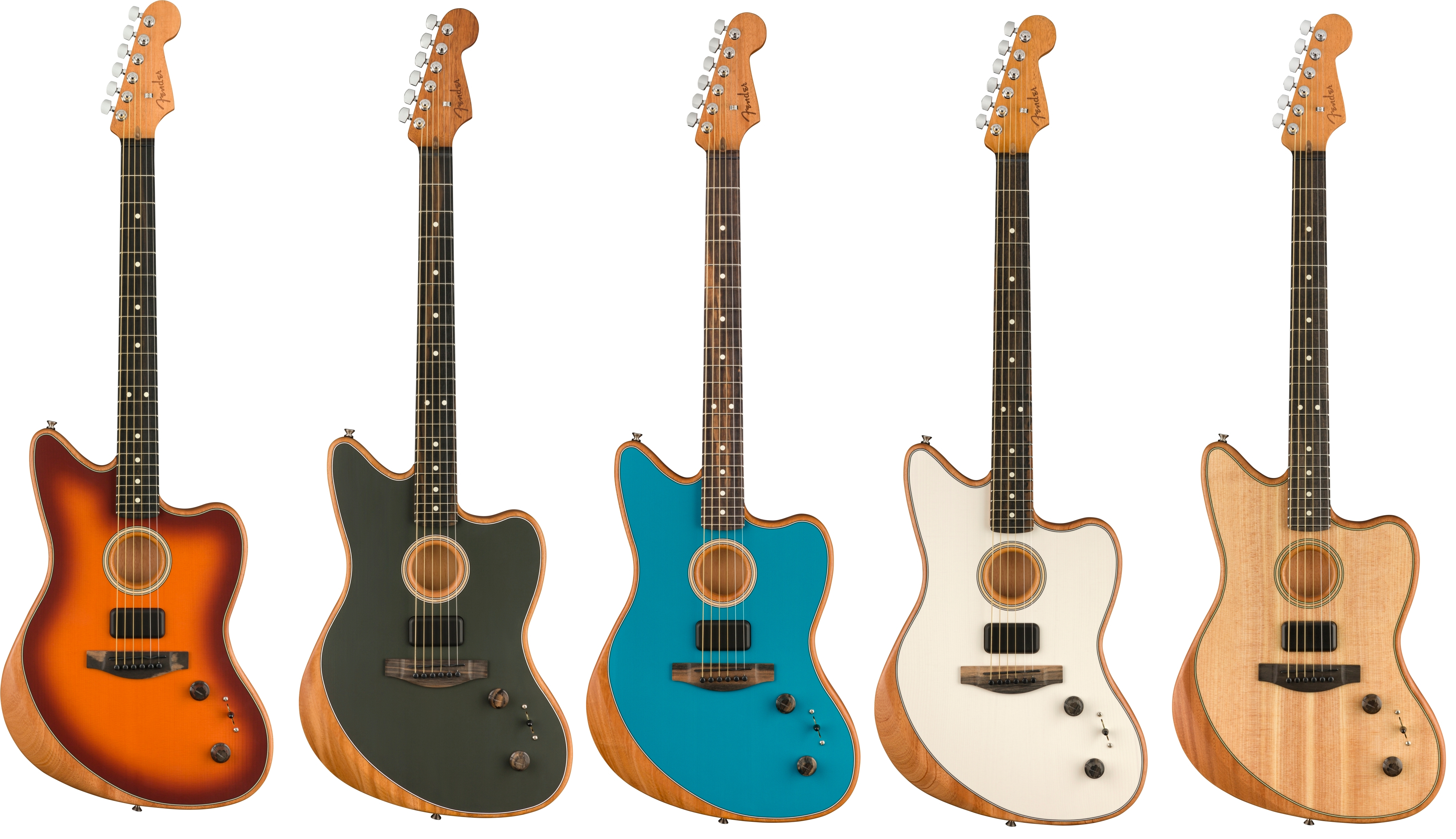
Some of the most popular colors for guitar bodies are:
- Natural: This is the color of wood that hasn’t been stained or painted.
- Black: Black is a popular color for metal-style guitars.
- Sunburst: Sunburst is a combination of light and dark colors, usually red, yellow, and brown.
Choosing a guitar based on its color is purely a matter of personal preference.
But if you do take your time and choose something that you’re happy with, you’ll be much more likely to play it often and develop your skills quicker.
– Bridge, Saddle, and Pins
The Fender Acoustasonic Jazzmaster has a standard pin bridge with black-colored pins and a saddle made of Graph Tech TUSQ.
Each of these elements contributes to the tone and feel of the acoustic guitar.
For instance, the bridge is in charge of transmitting string vibrations to the guitar’s body.
The saddle, which is often composed of plastic or bone, is where the strings rest.
And the pins are what hold the strings in place.

There are several kinds of bridges, each with its own set of benefits and drawbacks.
On acoustic guitars, you’ll mainly see three types of bridges:
- Pin bridges (standard)
- Pinless bridges
- Classical bridge
Pin bridges are the most common type of bridge, and they’re also the easiest to replace.
However, they can be a bit more difficult to intonate, which means getting the strings in the correct position.
Pinless bridges are less common, although they are easy to intonate as well.
They also have the advantage of not requiring any pins, which can be a pain to keep track of and must be replaced often.
Lastly, classical guitar bridges are only used on classical guitars.
They are similar in design to most other bridges, but the key distinction is that they have no pins and instead consist of a saddle and a wooden block with a hole for each string.
Said hole is used to tie the string down, which gives the guitar a much cleaner look.
Now, the type of saddle you choose is also important; plastic saddles are the cheapest and easiest to find, but they don’t last as long as bone saddles.
Bone saddles are more expensive, but they’re also more durable.
As for the bridge pins, there are three main types:
- Plastic bridge pins
- Steel bridge pins
- Brass bridge pins
Plastic bridge pins are the cheapest and easiest to find, but they are known to be the least durable.
Steel bridge pins are more expensive, but they’re also more durable in many ways.
Brass bridge pins are the most expensive, but they’re also the most durable our of the three.
Neck
The Fender Acoustasonic Jazzmaster has a neck that’s made of Mahogany with a Modern “Deep C” shape and a Bi-Flex truss rod.
A guitar’s neck is the part that extends from the body to the headstock and contains the fretboard.
Since different woods have distinct qualities that influence how the vibrations created by the strings behave, the type of wood chosen for the neck can affect the guitar’s playability and sound.
The most common type of neck is the bolt-on neck, which is screwed or bolted onto the body of the guitar.
Another popular type is the set-neck, which is simply glued to the body.
The fretboard, frets, nut, and truss rod are all crucial components of a guitar neck that also need to be considered when purchasing an instrument.
Fretboard
The fretboard is the part of the guitar’s neck where the player presses their fingers to make the strings vibrate and create sound.
Its wood, construction, as well as its radius (how curved it is), will affect the feel of the guitar and how easy it is to play.
The Fender Acoustasonic Jazzmaster has a fretboard made of Ebony with white dot inlays and a 12″ (305 mm) radius:

Despite the fact that this has long been a source of debate, it is generally accepted that the type of wood used for the fretboard might have a minor impact on the sound of the guitar.
Maple, for example, is a popular wood for electric guitars because it produces a very bright tone.
Rosewood is another popular choice, and it is frequently used on acoustic guitars because it produces a warm, full-bodied tone.
Ebony is yet another popular choice, and it’s often used on guitars that are meant to have a really clean, clear sound.
There are many different types of fretboards available, each with its own advantages and disadvantages.
It’s ultimately up to you to decide the type of fretboard you want, the tone of the guitar won’t be significantly different, but the feel of the guitar could be.

Brand Info
Fender is a leading manufacturer of electric guitars, and they’ve been in business since 1946.
They’re one of the most iconic guitar brands in the world, and their instruments are used by some of the most famous musicians of all time.
Also, the company offers a wide range of different models, from simple beginner guitars to complex professional instruments.
Their guitars are known for their great tone and quality craftsmanship, and they’re a popular choice for both beginner and experienced players.
At the same time, Fender guitars are very affordable, making them a great option for budget-conscious musicians.

Videos
For those of you who want to get a more in-depth look at this guitar, we’ve included some videos below.
The first video is a demo showing off how it sounds and looks.
While the second video is a review that goes over some of its features and specs.
Demo
Review
Specifications
A guitar’s specifications can tell you a lot about the instrument, and they can be helpful when you’re trying to decide between different models.
Below, we’ve included the specifications for the Fender Acoustasonic Jazzmaster:
– General
| Brand | Fender |
| Model | American Acoustasonic Stratocaster |
| Type | Acoustic |
| Size | Full Size |
| Number of Strings | 6 |
| Hardware Plating | Nickel |
| Tuning Machines | Open gear and die-cast |
| Electro-acoustic | Yes |
| Built-in Tuner | No |
| Colors | Natural, Ocean Turquoise, Tobacco Sunburst, Tungsten, Arctic White |
– Body
| Body Style | Modified Jazzmaster |
| Cutaway | Yes |
| Solid Top | Yes |
| Top Material | Solid A Sitka Spruce |
| Back Material | – |
| Sides Material | – |
| Finish Type | Polyester Satin Matte |
| Pickguard | No |
| Pickguard Design | Not applicable |
| Strap Buttons | Yes |
| Strap Buttons Position | Bottom and top edge |
| Strap Buttons Design | Classic |
– Neck
| Neck Material | Mahogany |
| Neck Shape | Modern “Deep C” |
| Scale Length | 25.5″ (64.77 cm) |
| Truss Rod | Bi-Flex |
– Fretboard
| Fretboard Material | Ebony |
| Fingerboard Inlay | White Dot |
| Number of Frets | 22 |
– Bridge, nut, saddle, pins
| Bridge Pins | GraphTech Tusq |
| Pin Color | Black |
| Bridge Material | Modern Asymmetrical |
| Saddle Material | Graph Tech TUSQ |
| Nut Material | Graph Tech TUSQ |
| Nut Width | 1.6875″ (42.86 mm) |
Please note that some brands might change the features and type of materials that they have and use on their guitars.
If you see a discrepancy in any of these specifications, please let us know and we’ll correct it.
I also encourage you to check out our other guitar reviews if you’re looking for something specific that you might have not found here with this guitar.
We have reviews on electric guitars, acoustic guitars, bass guitars, effects pedals, and more.
No matter what your budget is, or what type of guitar you’re looking for, we should be able to help you find the perfect one for you.

Born and raised in Florida! I’ve been playing guitars for the past 5 years. Love to learn, and I’m always striving to achieve greater heights in music. Currently have a Fender Stratocaster as my main guitar.

